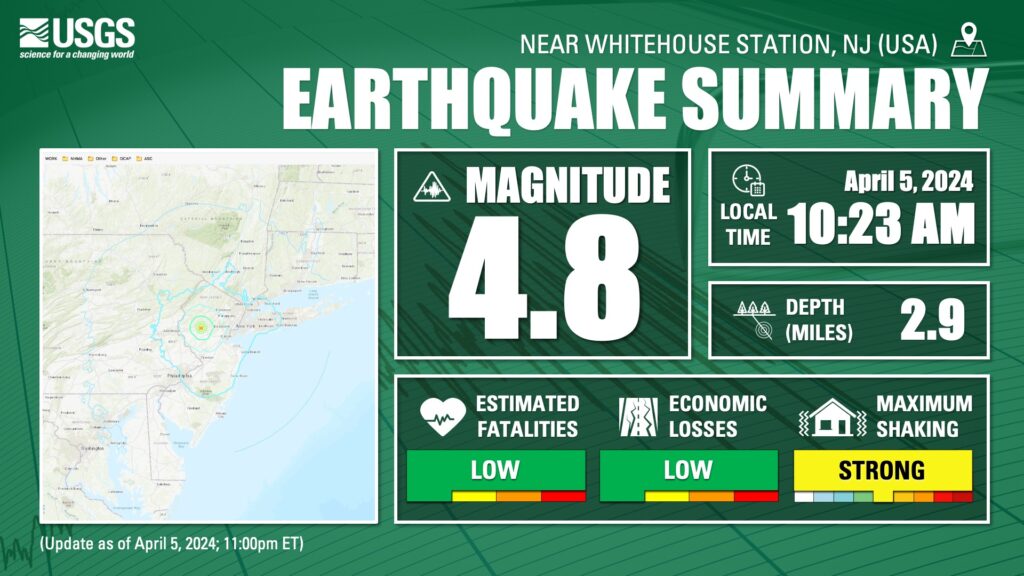NEW YORK—An earthquake shook the densely populated New York City metropolitan area the morning of April 5, with residents across the Northeast reporting rumbling in a region unaccustomed to it.
The U.S. Geological Survey reported a quake at 10:23 a.m. with a preliminary magnitude of 4.8, centered near Whitehouse Station, New Jersey, or about 45 miles west of New York City and 50 miles north of Philadelphia. The agency’s figures indicated that the quake might have been felt by more than 42 million people.
People from Baltimore to the Massachusetts-New Hampshire border reported feeling the ground shake. While there were no immediate reports of serious damage, officials were checking bridges and other major infrastructure, Amtrak slowed trains throughout the busy Northeast Corridor, and a Philadelphia-area commuter rail line suspended service out of what it said was “an abundance of caution.”
In midtown Manhattan, traffic grew louder as motorists blared their horns on shuddering streets. Some Brooklyn residents heard a boom and felt their building shaking. Cellphone circuits were overloaded for a time as people tried to reach loved ones and figure out what was going on.
Snow showers lingered on April 5 as the cleanup began following a major spring storm that brought heavy snow, rain and high winds to the Northeast, left hundreds of thousands of homes and businesses without power, and contributed to at least two deaths.

Well over a foot of snow, accompanied by gusty winds, was reported in many parts of northern New England by the evening of April 4. Some areas got closer to two feet.
“This is a lot of heavy, wet snow,” said Shawn Black, manager of the Wolfeboro Inn in New Hampshire, which got over a foot. “And the wind is out of the northeast, so it’s really not nice in a sense of temperature-wise, especially when the speed gets up to gusts of 55 mph. While I was out on the snowblower I could really feel my forehead just go numb.”
Stowe, Vermont, reported 20 inches of snow, the National Weather Service office in Burlington reported. The agency’s office in Gray, Maine, said it had 17.4 inches. The Concord Municipal Airport in New Hampshire was on the lower end, at 7.4 inches.
Thousands of homes and businesses were without power April 2 as severe weather roared through several states, causing at least one death and spawning possible tornadoes.
Parts of Ohio, Pennsylvania, Kentucky, Mississippi, Alabama, Tennessee, West Virginia, Virginia and Georgia were under tornado watches, while Wisconsin was experiencing a spring snowstorm.

Storms in Northeastern Oklahoma unleashed three suspected tornadoes and dumped heavy rain that was blamed for the death of a 46-year-old homeless woman in Tulsa who was sheltering inside a drainage pipe.
In West Virginia, about 140,000 customers were without electricity April 2, or about 14 percent of all customers tracked in the state by poweroutage.us. A storm blew off part of a vacant building’s roof in Charleston, littering the street with bricks and closing the roadway to traffic. Trees were uprooted and lay in roads, lawns and in some cases, on top of cars.
Gov. Jim Justice declared a state of emergency for several counties and urged people to “exercise extreme caution.”
Northeast of Cincinnati, part of Interstate 75 was blocked April 2 afternoon when about a half-dozen power poles toppled in high winds near Wetherington, WLWT-TV reported.
More than 70,000 homes and businesses in Wisconsin had lost power the night of April 2, according to poweroutage.us.
Kentucky Gov. Andy Beshear declared a state of emergency after severe storms swept through his state the morning of April 2.
“We have reports of substantial damage to a number of structures—and thankfully, as of right now we are not aware of any fatalities,” Beshear said in a statement.
The National Weather Service confirmed a tornado in northeast Tennessee on April 2. A funeral home and a house were damaged in the town of Sunbright, a town of about 500 people, said Matthew Brown, Morgan County’s 911 director. Power lines and trees were down, and some roads were closed, he said.
The utility company in Memphis, Tennessee, reported that about 40,000 homes and businesses lost power temporarily the morning of April 2 after an electric substation was struck by lightning, which then affected two other substations.
Storms also swept through far southwestern Indiana, toppling trees and causing power outages, leading several local school districts to cancel classes. More than 18,000 homes and businesses were without power shortly before noon on April 2, including in Vanderburgh County, home to Evansville, Indiana’s third-largest city.
As more storms approached California, officials closed a scenic stretch of iconic Highway 1 where a giant section collapsed into the ocean following heavy weekend rains.
The Monterey County Sheriff’s Office had warned residents of parts of the coastal community of Big Sur to evacuate April 3 before the road closed later that day. The road was expected to be closed for several days until the weather event passes, the office said. The Carmel Unified School District said the evacuation warning led to the closure of an elementary school and preschool on April 4 and April 5, news outlets reported.
Convoy passage for vehicles through the area being repaired, planned for April 4 and April 5, was canceled because of the forecasted rain, but was set to resume, the California Department of Transportation posted on social media.
The collapse occurred near Rocky Creek Bridge, about 17 miles south of Monterey, temporarily stranding as many as 1,600 people in Big Sur. Most of the people trapped there were able to leave when a single lane was reopened March 31.
The famous route has seen frequent closures because of collapses, mudflows and rockslides during severe weather. Compiled from Associated Press reports













